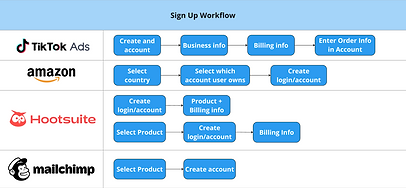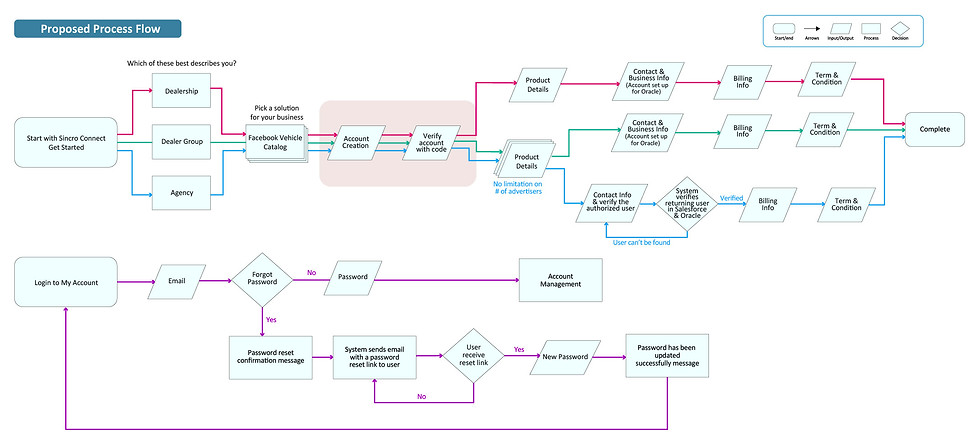Enhancing Order Fulfillment and Customer Self-Service
Tired of clunky signup processes and endless customer support tickets? This project transformed our customer experience. We streamlined order fulfillment and launched self-service account management, boosting customer satisfaction while cutting support costs. Learn how we tackled a complex integration, building a scalable solution that empowers customers and fuels future growth.

CLIENT Digital Ad Company
ROLE UX/UI Designer
Project Overview
This project aims to improve order fulfillment by collecting comprehensive information. A key component is empowering customers with self-service capabilities for managing their account, subscription and payment information. The current signup workflow is tightly integrated with the Facebook Vehicle Catalog, which limits flexibility as the company expands its product and service offerings. A more adaptable signup flow is crucial for seamless integration of future products.
Project Goals:

Streamline the subscription and account creation process

Empower customers with self-service account management tools

Reduce customer support volume related to account and payment issue
The Problem
The website currently limits customers to subscribing only to the Facebook Vehicle Catalog. Payment issues, such as expired credit cards, require customers to contact support, adding to the team's workload. Additionally, customers cannot view their subscriptions on the website. The rigid signup process and lack of self-service options create unnecessary friction and inefficiencies.

Rigid Signup Process
The existing signup flow was inflexible, limiting the company's ability to expand product offerings.

Limited Self-Service
Customers lacked the ability to manage their account information, leading to increased reliance on customer support.

Inefficient Order Fulfillment
The current process required customers to re-enter information, creating friction and hindering efficiency.
Research Process
User Flow Analysis
Analysis of the existing signup flow revealed key areas for improvement. Currently, account creation occurs after customers provide product details, business information, and contact details. This process is inefficient for returning customers whose information is already in the system. Requiring them to re-enter data creates unnecessary friction and a poor user experience.

Competitive Analysis
To facilitate customer self-service for account and payment management, research was conducted on best practices. A competitive analysis of account management features on other business websites was performed to identify effective layouts and information architecture. This research informed the design of the new account management page, ensuring a user-friendly and intuitive experience.

Table illustrating the signup workflow across companies in industry

Table displaying the order of account management navigation items across companies in industry
Workflow Mapping
Furthermore, a thorough understanding of the account information update workflow was necessary before designing the user interface. This involved mapping out the steps involved in updating various data points to ensure a smooth and efficient process.

Defining a Solution
This project implements two key solutions to address the identified problems:
Streamlined Order Fulfillment: The order fulfillment process has been redesigned to improve processing times and enhance overall efficiency. This is particularly beneficial for returning customers, who will experience a significantly faster and smoother ordering experience. The streamlining focuses on optimizing the flow of information and actions required for order completion.

Self-Service Account Management: A dedicated account management page has been introduced, empowering customers with the ability to independently manage their account, product subscriptions, and payment information. This self-service capability enhances customer satisfaction by providing them with greater control over their data. By reducing the volume of customer support inquiries related to account and payment updates, this feature also contributes to significant cost savings.

To visualize the design solution, please view the interactive prototype via this link.
Impact
This project is expected to significantly improve usability and contribute to key business goals by addressing current limitations and introducing enhanced features. The anticipated impact includes:

Enhanced Customer Experience
-
Increased Customer Satisfaction: Empowered customers with self-service tools will lead to increased satisfaction by reducing frustration and improving overall ease of use.
-
Streamlined Signup: The streamlined signup process, especially for returning customers, will result in a more positive user experience.

Improved Business Operations
- Reduced Customer Support Costs: By empowering customers to self-serve, the volume of support tickets related to account and payment issues will decrease, freeing up customer support resources for more complex inquiries.
-
Improved Order Fulfillment Efficiency: Streamlined data collection will lead to faster order processing, reduced errors, and increased efficiency across the order fulfillment process.

Business Growth
- Increased Conversion Rates: The simplified and more flexible signup process will lower the barrier to entry for new customers, driving increased conversion rates.
-
Enhanced Scalability: Decoupling the signup flow from the Facebook Vehicle Catalog provides the foundation for seamless integration of future products and services, enabling the company to scale effectively and support future business growth.
In summary, this project is expected to have a positive impact on both customer experience and business operations, contributing to increased customer satisfaction, reduced costs, improved efficiency, and enhanced scalability.
Future Plans
This project represents a significant step forward in enhancing the customer experience. However, to further optimize the platform, Phase 2 will focus on the following:

Integrating Account Information Updates with Salesforce: Currently, customers cannot independently update their business and contact information within the Salesforce system. Phase 2 will address this technical limitation by enabling seamless integration between the customer portal and Salesforce, allowing for real-time updates.

Expanding Self-Service Capabilities: We will continue to enhance self-service capabilities by allowing customers to update a broader range of account information directly through the account management interface.

Platform Scalability: Building upon the flexible signup flow implemented in this project, Phase 2 will expand the platform to accommodate the company's growing portfolio of products and services. This will ensure the platform remains scalable and adaptable to future business needs.